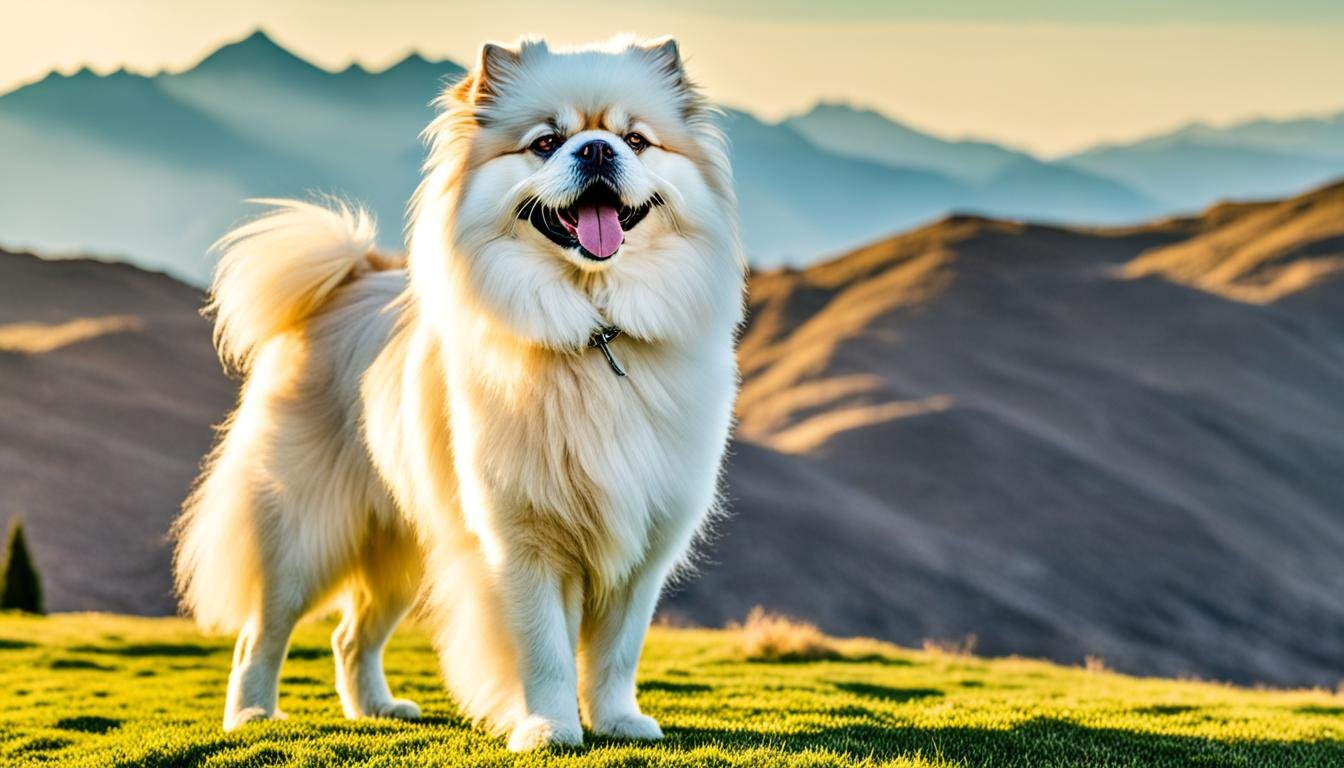The Persian Sarabi dog is a giant among dogs, with roots in Iran. It is tall, ranging from 28–35 inches, and heavy, with males weighing 140 to 200 pounds. This breed is a majestic representation of the canine world.
Native to Sarab County, the Persian Sarabi is known for its vast size and loyalty. These dogs can live for 12–15 years. They come in colors like fawn, sable, and black. These colors suit their noble and practical lives.
The Persian Sarabi dog’s loyalty is remarkable. They need a home with plenty of space, ideally with a big yard. As a guardian dog, they have a strong spirit. They require owners who are skilled in handling such magnificent beasts.
An Introduction to the Persian Sarabi Dog
The Persian Sarabi dog is huge and great at guarding. It is called the Iranian Sarabi dog or Persian Mastiff too. It comes from Sarab county in East Azerbaijan, Iran. These dogs are known for being strong and loyal, which puts them among the biggest dog breeds.
The size and strength of the Persian Mastiff may look scary. But with the right training, it becomes a loving yet protective friend. It’s best for people who know how to handle big dogs. They need special care and training to be safe and happy.
In Iran, the Sarabi Mastiff is one of the strongest breeds. They’re not just protectors; they care deeply for their families. This makes them perfect for both rural and suburban homes. Yet, due to their size, it’s important to watch them around small kids and pets.
| Feature | Detail |
|---|---|
| Height (Male) | Minimum 30 inches |
| Weight (Male) | Up to 200 pounds |
| Height (Female) | Around 27 inches |
| Weight (Female) | Up to 150 pounds |
| Life Span | 8-11 years |
| Common Health Issues | Hip Dysplasia, Bloating |
| Bathing Frequency | Every 6-8 weeks |
The Persian Sarabi dog doesn’t need a bath often, unlike other smaller breeds. They have fewer health problems compared to other large dogs. This makes the Iranian Sarabi not just impressive in size but also easy to take care of for those ready for such a big pet.
Historical Significance and Origins

The Persian Sarabi Dog is from Sarab County, Iran. It has a strong history as a guardian of livestock. Its importance is noted in historic writings and its role in helping shepherds for centuries.
This breed has been a key protector against predators. Because of this, it has a special place in both rural and urban stories.
The Sarabi’s Role in Sarab County, Iran
In Sarab County, the Persian Sarabi Dog has been more than a guardian. It has protected the community’s lifestyle. Shepherds have relied on them for centuries. They kept safe livestock from predators and thieves.
Thanks to their strength and instincts, they were irreplaceable in Iran’s pastoral areas.
From Livestock Guardian to Domesticated Breed
Originally, the Persian Sarabi Dog was a guardian for livestock. Now, its roles have changed. It still guards flocks but also becomes a loyal family pet.
Its strong loyalty and instincts fit well into home life. Now, it’s both a loving pet and a home protector. This breed shows how a working dog can become a cherished family member while keeping its valued traits.
Physical Characteristics of the Persian Sarabi Dog
The majestic Persian Sarabi dog stands out among mastiff breeds. It’s famous for its huge size and strong body. These dogs are the definition of grace and muscle, born for watching and defending.
Stature and Build: Understanding the Giant Size
The Persian Sarabi is among the biggest dog breeds. It has a wide chest and a strong body, showing it’s a great guard dog. Male Sarabi dogs are tall, measuring 32-35 inches and weigh 143-198 pounds. Some are even heavier. Females are a bit smaller, standing 28-32 inches and weighing 110-154 pounds. Their size doesn’t just look impressive; it’s vital for their job in protecting livestock.
Coat Quality and Color Variations
This dog’s coat comes in fawn, sable, and deep black colors. The coat is thick and mid-length, which keeps them warm in cold weather. You might see a black mask or other markings that make their faces even more unique. Their coat needs regular grooming to stay shiny and healthy. This care is part of keeping such majestic animals in top condition.
The Persian Sarabi dog’s body, from its huge size to its dense coat and unique colors, makes it a top breed. They carry the history of ancient mastiff breeds. It’s key to know their needs and traits to give them a good life, keeping their health and legacy in mind.
Temperament and Social Traits

The Persian Sarabi dog is known for being a great guardian and a gentle family member. They are smart and always on the lookout, ready to protect their home. These dogs are intense when guarding but gentle with their families.
This breed is extremely loyal and makes strong bonds with their families. They are big but control their power, rarely being too aggressive. Their protective nature makes them great pets, especially for kids they are very caring towards.
Loyalty and Protective Nature
Persian Sarabi dogs are known for their deep loyalty, always staying close to their owners. They naturally protect, giving their families peace of mind. They are calm and alert, making them perfect watchdogs and friends.
Interaction with Family and Other Pets
Within the family, Persian Sarabi dogs are both watchful and loving. They love being part of the family and are very kind to children. But, their interactions with other pets need careful attention because of their strong hunting instinct. Starting socialization early is key to help them get along well with everyone at home.
| Feature | Detail |
|---|---|
| Temperament | Protective, loyal, intelligent |
| Socialization needs | High; essential for good household integration |
| Interaction with children | Highly protective and affectionate |
| Behavior with other pets | Can be managed with early and consistent training |
| Guardian capability | Exceptional; natural guard instincts |
The Persian Sarabi dog doesn’t just guard homes; they guard hearts too. They mix bravery with kindness, making them top-notch family pets and guardians.
Training and Mental Engagement
Training and mental engagement are key in raising a Persian Sarabi dog. These dogs, known for guarding livestock, need robust training. Early and regular socializing helps control their guarding instincts. This makes them fit well into various settings.
Importance of Early Socialization
Start socializing Persian Sarabi dogs early to use their natural skills and help them adapt to different situations. By meeting various people, animals, and exploring new places, they become less likely to act aggressively. This approach makes them more balanced and better at training.
Training Challenges with Independent Breeds
Persian Sarabi dogs may resist training because they like to make their own decisions. They are smart, but training them needs patience and consistency. Using positive reinforcement is key to teaching them good behaviors and obedience. Trainers must be persistent and understanding, avoiding punishment.
The training also involves engaging their minds. Such mental exercises are vital for dogs with active roles like livestock guardians. An engaged Sarabi is more manageable and content.
By focusing on the unique needs of Persian Sarabi dogs with specific training and socialization, a strong bond forms between the dog and its owner. This aligns with the best care for independent breeds in varying environments.
Dietary Needs and Nutrition

The Persian Sarabi dog is a large breed, famous for its size and guardian nature. It needs a special diet to stay healthy and energetic. Good nutrition is vital for them. It’s not just about how much they eat but what they eat. Their big size and high energy require a unique diet. This diet helps avoid obesity and ensures the dog lives a long, healthy life.
It’s important to control a Persian Sarabi’s food intake. This prevents weight gain. Being overweight can cause serious health problems. Giant breeds can have joint issues and other complications from being too heavy. A diet that’s rich in nutrients but low in calories is key. It helps keep them at a healthy weight.
- High-quality protein sources to support muscle strength and maintenance
- Fats for energy, especially for active breeds like the Sarabi
- Fibers for digestive health and weight management
- Vitamins and minerals to support bone health, immune system, and overall well-being
Talking to a vet about your Sarabi’s diet is a good idea. They can help make a plan that meets your dog’s needs. This plan should consider the dog’s age, weight, and activity level. It should also account for any health issues. A diet chart with specialized dog food for giant breeds can be very helpful.
The nutrition plan should have both dry and wet food. This adds variety and keeps your dog interested in their meals. It’s important for their health. Foods from well-known brands for large breeds are best. You want food that supports the unique needs of giant breeds, like bone and joint health.
In summary, the diet of a Persian Sarabi dog needs careful management. It’s all about balance and avoiding overfeeding. Customized nutrition plans, regular vet visits, and watching the dog’s response to its diet are crucial. These steps will truly make a difference in their health.
Exercise and Activity Requirements
Knowing how much exercise a Persian Sarabi dog needs is important if you’re thinking of getting one. They are energetic and need lots of physical activity and brain games to stay healthy and happy. If they don’t get enough exercise, they might start behaving badly, like chewing things up or barking a lot.
This breed needs the same level of activity as other big working dogs. They need plenty of room to run and play. Since they like to move around a lot, living in a small apartment isn’t a good idea for them. A home with a big yard that’s safe and secure is perfect for their energy needs.
Catering to the Sarabi’s Energy Levels
Persian Sarabi dogs require more than just short walks. They love to take part in action-packed activities like running, hiking, and agility training. Engaging in these activities gives them the physical workout and mental challenge they crave. It also stops them from getting bored and acting out.
Space Considerations for Adequate Exercising
Having a big outdoor area is great for Persian Sarabi dogs. Such spaces are not just for their physical activity but also for smart training activities. Playing fetch, Frisbee, and doing obstacle courses are great for them. These varied activities meet their exercise needs, which keeps them in good shape and sharpens their minds.
| Dog Group | Exercise Needs (Minutes per Day) | Recommended Activities |
|---|---|---|
| Scent Hounds | 60-90 | Long hikes, tracking exercises |
| Terriers | 60-90 | Intense play like chasing a ball |
| Working Dogs (Including Persian Sarabi) | 60-120 | Hiking, running, agility training |
| Sporting Dogs | 60-120 | Running, swimming, fetching games |
| Herding Group | 60-120 | Vigorous exercise with agility tools |
Being well-informed and having the right tools to take care of a Persian Sarabi is crucial. This includes knowing about exercise routines and how to keep their minds active. This will ensure you have a joyful and healthy pet.
Healthcare and Common Health Issues
Persian Sarabi dog owners must know about the breed’s health issues. These dogs are usually strong and can live 12 to 17 years. Still, they can get hip dysplasia, bloat, and eye problems. It’s crucial to have regular vet visits and take steps to prevent these issues. Let’s look at important healthcare tips and common problems for Persian Sarabi dogs.
Preventative Health Measures
To keep a Persian Sarabi dog healthy, start with regular vet visits and a good diet. This prevents obesity and issues like hip dysplasia, common in young dogs. Bloat is very dangerous and needs quick action. Knowing its warning signs and how to prevent it is key.
Medicine that helps with joint pain can make a big difference. It slows down joint damage. Taking steps to prevent health problems helps Persian Sarabi dogs live better lives.
Genetic Disorders and Screening
Though Persian Sarabi dogs are mostly healthy, genetic tests are still smart. It helps catch diseases early. Purebreds like them are more likely to get sick than mixed breeds. Rottweilers and German Shepherds, for example, are often sicker than crossbreeds.
Adding genetic tests to their vet care helps find and treat diseases early. This way, these noble dogs can live long and healthy lives. It shows how to care for a healthy breed.
FAQ
What are the defining breed traits of the Persian Sarabi Dog?
The Persian Sarabi Dog stands out for its huge size and strong body. These dogs are known to be loyal and smart. They originally come from Iran and are great for those who can handle strong, big dogs.
How did the Persian Sarabi Dog get its name?
This breed gets its name from Sarab County in Iran’s East Azerbaijan. For centuries, they have guarded livestock against wolves and bears.
What is the historical significance of the Persian Sarabi Dog?
Historically, these dogs protected sheep and goats from predators. They have been key for Iran’s shepherds for hundreds of years.
What are some physical characteristics of the Persian Sarabi Dog?
Persian Sarabi Dogs are huge, with broad chests and strong muscles. They sport a dense coat in colors like fawn and black. These may have distinctive markings.
Can you describe the temperament of the Persian Sarabi Dog?
These dogs show loyalty, smarts, and a protective nature. They are calm and cautious around strangers. Thus, they make great family guardians. It’s important to socialize them well.
What are the training and socialization needs of a Persian Sarabi Dog?
Early socialization and regular training are key. Persian Sarabi Dogs do well with positive reinforcement. This ensures they grow into well-behaved pets.
What type of diet is suitable for the Persian Sarabi Dog?
A diet fit for giant breeds works best for Persian Sarabi Dogs. Watch their portions to avoid obesity. A vet can give dietary advice unique to them.
How much exercise does a Persian Sarabi Dog need?
These dogs are energetic and need a lot of exercise daily. Walks and play in a secure yard are musts. They also need activities to keep their minds active.
What are common health issues in Persian Sarabi Dogs?
They might face hip dysplasia, bloat, obesity, and eye troubles. Regular check-ups and knowing about these risks help keep them healthy.













